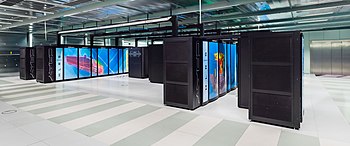

The High Performance Computing Center (HLRS) in Stuttgart, Germany, is a research institute and a supercomputer center. HLRS has currently a flagship installation of a HPE Apollo 9000 system called Hawk 26 PFLOPS peak performance replacing the Cray XC40 system called Hazel Hen, providing ~7,4 PFLOPS peak performance. Additional systems include NEC clusters (NEC SX-ACE systems for testing, NEC Vulcan + Vulcan2 for non-critical computing) and Cray CS-Storm cluster.
Known historical configurations:
1996 - Cray T3E / 512 + NEC SX-4
2000 - Hitachi SR-8000 + NEC SX-5 / 32M2
2003 - ? (Opteron/Xeon cluster) + NEC SX-6
2005 - NEC SX-8
2008 - IBM BW-Grid + NEC SX-9
2009 - Cray XT5M
2010 - Cray XE6 "Hermit"
2014 - Cray XC40 "Hornet"
2019 - Cray CS-Storm
2020 - HPE Apollo 9000 "Hawk" + NEC (Vulcan + Vulcan2 + NEC SX-ACE).
See also
References
- Itanium rising: breaking through Moore's second law of computing power by Jim Carlson, Jerry Huck 2002 ISBN 0-13-046415-5 page 29
- "Next-Generation HPC System @ HLRS". 13 February 2020. Retrieved 23 February 2020.
- HLRS High Performance Computing Center Stuttgart - Cray XC40 (Hazel Hen) Archived 2018-11-03 at the Wayback Machine, HLRS High Performance Computing Center Stuttgart, retrieved 2017-11-23
- ^ "HLRS High Performance Computing Center Stuttgart - Systems". www.hlrs.de. Retrieved 2020-12-12.
External links
48°44′22″N 9°05′50″E / 48.73944°N 9.09722°E / 48.73944; 9.09722
This supercomputer-related article is a stub. You can help Misplaced Pages by expanding it. |